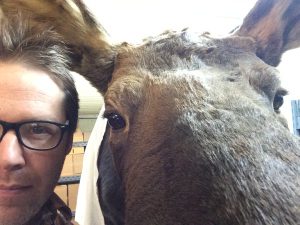
People & Culture
Canadians share their love for museums with selfies
#MuseumSelfie trended on Twitter January 20th as people the world over shared their snaps.
- 564 words
- 3 minutes
This article is over 5 years old and may contain outdated information.
Travel
Peek inside the collections of this medical history museum with these five revealing items

The macabre, and sometimes gruesome, specimens inside Philadelphia’s Mütter Museum can make visitors feel more like they’re walking through a haunted house than an educational institution. The medical history museum, part of The College of Physicians of Philadelphia founded in 1787, is dedicated to displaying preserved anatomical specimens (read: body parts and skeletons), models and instruments. Permanent collections include everything from approximately 1,300 wet specimens of every part of the human body to skeletons with rare genetic disorders, while special exhibitions delve into thematic displays. Here are five famous and must-see items in the museum’s collection.
The Soap Lady
Named for the appearance of soap covering her remains (it’s actually a fatty substance called adipocere that forms on corpses in certain environments), the Soap Lady’s body was exhumed at a Philadelphia cemetery in 1875. It was originally reported by Joseph Leidy, the doctor who procured her body after she was exhumed, that she died in 1790 during the yellow fever epidemic at the age of about 40. However modern x-ray technology has placed her death around 1830 and closer to the age of 20.
Cast and livers of Chang and Eng Bunker
This exhibit takes the nickname, “city of brotherly love” to a new level. These conjoined twins were born in Thailand in the early 1800s and came to the United States in 1829 to tour and lecture. They married and stayed in the country (they had 21 children between them!) and when they passed in 1874, The College arranged for their conjoined liver to be sent to the museum. Today, their liver is on display as is a plaster cast of their torsos.
Albert Einstein’s brain
The renowned physicist’s brain, sections of which are preserved in glass slides and displayed in the museum, is not normal. First, though the brain weighed a little less than the average male’s brain, it was reported to be 15 per cent larger in the parietal region (the are that processes sensory information). Second, some scientists think it lacked a crevice called the Sylvain fissure.
The story of how the brain came to museum is also abnormal. After Einstein died in New Jersey in 1955, pathologist Thomas Harvey autopsied his body and removed his brain without the family’s permission (Einstein’s wishes were to be cremated). He eventually received reluctant permission from Einstein’s son to keep the brain on the condition that it be used for scientific research. Harvey sliced the brain into 240 pieces and preserved them in celloidin, a rubbery type of cellulose. He then put the pieces into two glass jars and kept them in his basement, and later his apartment, for decades, sending bits and pieces to researchers upon request. Eventually, what was left of his collection was donated to the museum.
Mütter American Giant
Standing seven feet six inches tall, the tallest skeleton on exhibit in North America calls the Mütter home. The man had acromegaly, more commonly known as gigantism, a rare disorder where an excess of growth hormone is released from the pituitary gland (usually caused by a tumor on the gland). For scale, the skeletons that appear on either side of him are an average-height adult and that of Mary Ashberry, who was three feet six inches tall and had dwafism. While this man had a rare disorder, there are people who have reached this height without gigantism.
Speculations on impregnations in the human female
Judge this book by its cover. Speculations on impregnations in the human female, a book from the 1700s on display in the museum, is an example of an anthropodermic bibiopegy — that is, the practice of binding books in human skin. In the 1880s, Philadelphia physician Joseph Leidy covered the book with the skin of a deceased patient, Mary L. His colleague left a note on the inside of the book explaining how Leidy took the skin from the woman’s thigh and boiled it in a hospital chamber pot to prepare it for binding.
Are you passionate about Canadian geography?
You can support Canadian Geographic in 3 ways:

This story is from the Canadian Geographic Travel: Winter 2015 Issue

People & Culture
#MuseumSelfie trended on Twitter January 20th as people the world over shared their snaps.

Travel
Engage your curiosity and fuel your imagination with a visit to one of these top Canadian treasure troves

People & Culture
In honour of International Museum Day, Canadian Geographic's editors share their favourite museums in Canada

People & Culture
The event capped off two days of meetings between Members of Parliament, Senators, Hill staff and museum professionals from across the country